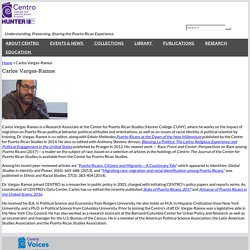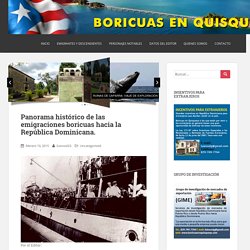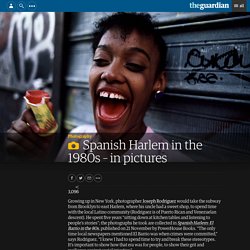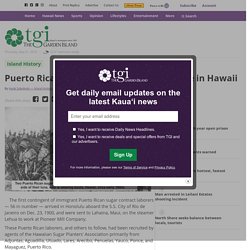

HathiTrust Digital Library. Carlos Vargas-Ramos - The Center for the Humanities. Carlos Vargas-Ramos. Carlos Vargas-Ramos is a Research Associate at the Center for Puerto Rican Studies (Hunter College-CUNY), where he works on the impact of migration on Puerto Rican political behavior, political attitudes and orientations, as well as on issues of racial identity.

A political scientist by training, Dr. Vargas-Ramos is co-editor, along with Edwin Meléndez,Puerto Ricans at the Dawn of the New Millennium published by the Center for Puerto Rican Studies in 2014. He also co-edited with Anthony Stevens-Arroyo, Blessing La Política: The Latino Religious Experience and Political Engagement in the United States published by Praeger in 2012. His newest work — Race, Front and Center: Perspectives on Race among Puerto Ricans (2017)— a reader on the subject of race, based on a selection of articles in the holdings of Centro: The Journal of the Center for Puerto Rican Studies, is available from the Center for Puerto Rican Studies. Dr. Puertorriqueños en Hawai - La primera emigración del siglo veinte. Mucho se ha escrito de la emigración de puertorriqueños al continente americano durante el siglo 20, ¿pero sabias tú que entre 1900 y 1901 cerca de 5,000 boricuas emigraron a las islas de Hawai?

Esta "primera" emigración es una historia interesante que merece difusión. Al igual que en Puerto Rico, en 1898, las islas de Hawai pasaron a ser un territorio de los Estados Unidos (EE.UU.). Esta transición generó cambios laborales en las plantaciones azucareras propulsando la búsqueda de otras fuentes de mano de obra dentro y fuera de los EE.UU. En agosto de 1899, el paso del huracán San Ciriaco terminó agravando la situación económica en Puerto Rico sirviendo de agente catalítico a la idea de la emigración en busca de trabajo en otras tierras. Esto creó así las condiciones que llevaron a un número de puertorriqueños a considerar la emigración como una opción para mejorar su condición económica. Buscando trabajadores Alberto E. Una nueva vida en Hawai. Panorama histórico de las emigraciones boricuas hacia la República Dominicana. Por el Editor: El actual movimiento migratorio de boricuas hacia la República Dominicana no es un evento histórico nuevo ni exclusivo de estos tiempos.

Lo que ocurre es que se repite la historia. Veamos los hechos históricos. Desde el siglo diecinueve la población de Puerto Rico ha sufrido tres grandes oleadas de migraciones hacia el extranjero. La primera aconteció desde la década del 80 del siglo diecinueve y se extendió hasta las primeras dos décadas del siglo veinte. La segunda gran oleada de migrantes boricuas hacia el extranjero se produce en las décadas del 50 y 60 del siglo pasado. La tercera gran oleada de migrantes boricuas hacia el extranjero es la que ahora estamos viviendo. Puerto Rico and the American Dream. Know Your Fellow American Citizen from Puerto Rico (1956?) by Javier Almeyda. Spanish Harlem in the 1980s – in pictures. Growing up in New York, photographer Joseph Rodriguez would take the subway from Brooklyn to east Harlem, where his uncle had a sweet shop, to spend time with the local Latino community (Rodriguez is of Puerto Rican and Venezuelan descent).

He spent five years “sitting down at kitchen tables and listening to people’s stories”; the photographs he took are collected in Spanish Harlem: El Barrio in the 80s, published on 21 November by PowerHouse Books. “The only time local newspapers mentioned El Barrio was when crimes were committed,” says Rodriguez. “I knew I had to spend time to try and break these stereotypes. It’s important to show how that era was for people, to show their grit and resilience against social injustice.” Joseph Rodriguez is represented by the Bene Taschen Gallery in Cologne, Germany. > <title>PRCAP (PR Citizenship Archives Project) State-to-State Migration Flows. Puerto Rican sugar contract laborers arrive in Hawaii - The Garden Island.
The first contingent of immigrant Puerto Rican sugar contract laborers — 56 in number — arrived in Honolulu aboard the S.S.

City of Rio de Janeiro on Dec. 23, 1900, and were sent to Lahaina, Maui, on the steamer Lehua to work at Pioneer Mill Company. These Puerto Rican laborers, and others to follow, had been recruited by agents of the Hawaiian Sugar Planters’ Association primarily from Adjuntas, Aguadilla, Utuado, Lares, Arecibo, Penuelas, Yauco, Ponce, and Mayaguez, Puerto Rico. A second group of nearly 400 Puerto Rican immigrants — about half being women and children — arrived at Honolulu on Jan. 16, 1901, on board the S.S. City of Peking and were transported to Maui and the Big Island aboard the steamer Helene, or were sent to Waialua and Ewa plantations on Oahu. It was not until Feb. 25, 1901, when the S.S. Hawaiian Sugar Co. at Makaweli, Kauai, was allocated 40 families that sailed for Kauai aboard the steamer Waialeale. JL18174.